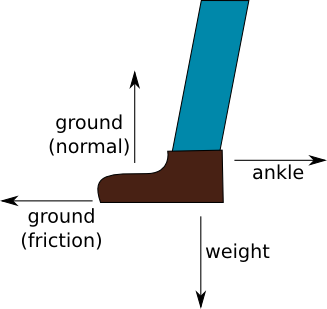Slippery slopes
Posted by David Zaslavsky on
I probably should not have worn my frictionless shoes out last night.
Oddly enough (for the end of March) it’s snowing in State College, which means that the sidewalks are slippery again, which reminded me that I’ve been meaning to follow up my previous post about slippery surfaces with one where I talk about hills.
There were two main points I made in the last post:
- friction with the ground is what allows you to accelerate (speed up, slow down, or change direction), and
- friction also helps keep your feet from slipping out from under you when you put them down as you walk.
I used a slightly unrealistic diagram of a foot as a visual aid:
Now compare that to the equivalent diagram for a foot on a hill:
On level ground, without friction, there’s no force pushing you along the ground. But the new diagram shows that that isn’t the case anymore on a hill. With no friction, gravity works to pull you down the slope. So in the absence of friction, you do accelerate — you slip down the hill.
Obviously, this is bad news if you’re trying to walk uphill. Even if …
